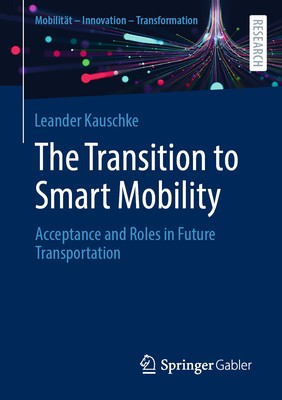
- We will send in 10–14 business days.
- Author: Leander Kauschke
- Publisher: Springer Gabler
- ISBN-10: 3658430001
- ISBN-13: 9783658430009
- Format: 14.8 x 21 x 1.8 cm, minkšti viršeliai
- Language: English
- SAVE -10% with code: EXTRA
Reviews
Description
Most contemporary notions of the fairly recent concept 'smart mobility' portray an imminent transition of similar socio-economic consequences as the shift from horses to automobiles did 100 years ago. Present book thus offers an in-depth look at the variables involved in the equation of smart mobility acceptance (1) and envisaged institutional change (2).
Both views are embedded in the Multi-Level Perspective. Study 1 develops a structural equation model in SmartPLS. Use cases cover eBikes (N=537), mobility-as-a-service (N=531), and fully automated vehicles (N=558). Based on the results, acceptance relies on five factors: performance expectancy, facilitating conditions, social influence, habit, and hedonic motivation.
Study 2 applies the Institutional Role Model (IRM) to better understand system dynamics. Thus, the smart mobility ecosystem is mapped in a structured manner. It identifies nine institutions, as well as four technical and four economic roles. Results of interviews with experts (N=8) support the IRM's significance as a vision provider for a new mobility regime.In the end, these two perspectives amalgamate. This opens a sophisticated space for public debate about the commencing transition to smart mobility.
EXTRA 10 % discount with code: EXTRA
The promotion ends in 22d.23:45:05
The discount code is valid when purchasing from 10 €. Discounts do not stack.
- Author: Leander Kauschke
- Publisher: Springer Gabler
- ISBN-10: 3658430001
- ISBN-13: 9783658430009
- Format: 14.8 x 21 x 1.8 cm, minkšti viršeliai
- Language: English English
Most contemporary notions of the fairly recent concept 'smart mobility' portray an imminent transition of similar socio-economic consequences as the shift from horses to automobiles did 100 years ago. Present book thus offers an in-depth look at the variables involved in the equation of smart mobility acceptance (1) and envisaged institutional change (2).
Both views are embedded in the Multi-Level Perspective. Study 1 develops a structural equation model in SmartPLS. Use cases cover eBikes (N=537), mobility-as-a-service (N=531), and fully automated vehicles (N=558). Based on the results, acceptance relies on five factors: performance expectancy, facilitating conditions, social influence, habit, and hedonic motivation.
Study 2 applies the Institutional Role Model (IRM) to better understand system dynamics. Thus, the smart mobility ecosystem is mapped in a structured manner. It identifies nine institutions, as well as four technical and four economic roles. Results of interviews with experts (N=8) support the IRM's significance as a vision provider for a new mobility regime.In the end, these two perspectives amalgamate. This opens a sophisticated space for public debate about the commencing transition to smart mobility.


Reviews